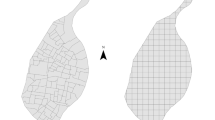Abstract
It is important to analyse the growth of gated communities and the drivers for their supply and demand, within the context specific to each country’s history. This article uses findings from recent studies of gated communities in England, together with historical material, to explore their typology. It considers the changing social, economic and political conditions which may lead to the emergence of defended collective housing, together with the history of property relations and the concept of public/private land within the English context.


Similar content being viewed by others
References
Atkins, P. J. (1993). How the west end was won: the struggle to remove street barriers in Victorian London. Journal of Historical Geography, 19(3), 256–277.
Atkinson, R., Blandy, S., Flint, J., & Lister, D. (2004). Gated communities in England. London: Office of the Deputy Prime Minister.
Babb, P. (2005). Focus on social inequality. London: Office for National Statistics.
Bauman, Z. (2001). Community: Seeking safety in an insecure world. Cambridge: Polity Press.
Blakely, E. J., & Snyder, M. G. (1997). Fortress America: Gated communities in the United States. Cambridge, MA: Lincoln Institute of Land Policy; Washington, D.C.: Brookings Institution Press.
Blandy, S., & Lister, D. (2005). Gated communities: (Ne)gating community development? Housing Studies, 20(2), 287–301.
Blandy, S., Lister, D., Atkinson, R., & Flint, J. (2003). Gated communities: A systematic review of the research evidence (CNR Paper 12). Bristol: ESRC Centre for Neighbourhood Research.
Collison, P. (1963). The Cutteslowe walls: A study in social class. London: Faber and Faber.
Darton, D., Hirsch, D., & Strelitz, J. (2003). Tackling disadvantage. A 20-year enterprise. York: Joseph Rowntree Foundation.
Garland, D. (2001). The culture of control: Crime and social order in contemporary society. Oxford: Oxford University Press.
Glasze, G. (2003). Segmented governance patterns – fragmented urbanism: The development of guarded housing estates in Lebanon. The Arab World Geographer, 6(2), 79–100.
Lawrence, H. W. (1993). The greening of the squares of London: Transformation of urban landscapes and ideals. Annals of the Association of American Geographers, 83(1), 90–118.
Marcuse, P. (1997). Walls of fear and walls of support. In N. Ellin (Ed.), Architecture of fear (pp. 101–114). New York: Princeton Architectural Press.
McKenzie, E. (1998). Homeowner associations and California politics: An exploratory analysis. Urban Affairs Review, 34(1), 52–75.
McKenzie, E. (1994). Privatopia: Homeowner associations and the rise of residential private government. New Haven and London: Yale University Press.
Mingay, G. E. (1998). Parliamentary enclosure in England. London: Longman.
Putnam, R. D. (2000). Bowling alone: The collapse and revival of American community. New York: Simon and Schuster.
Searle, M. (1930). Turnpikes and toll-bars. London: Hutchinson.
The Sheffield Telegraph. (15 May 1925). Estate barrier: Chain removed after seventy-five years.
The Independent. (26 May 2004). Retirement feature, property supplement.
Tomalin, C. (2002) Samuel Pepys: The unequalled self. London: Penguin Books.
Webster, C. (2001). Gated cities of tomorrow. Town Planning Review, 72(2), 149–169.
Wilson, E. (1991). The Sphinx in the city: Urban life, the control of disorder, and women. London: Virago Press.
Acknowledgements
The author gratefully acknowledges funding provided by the British Academy for the Sheffield study of a gated community and that provided by the Office of the Deputy Prime Minister for the national study of gated communities. This research was carried out with Rowland Atkinson and John Flint (University of Glasgow) and with Diane Lister (formerly Sheffield Hallam University, now the University of Cambridge) who have generously allowed use to be made of our joint findings. This paper was first presented at “The Privatization of Urban Space: Gated Communities – A New Trend in Global Urban Development?” conference at the University of New Orleans, 26–28 February 2004; the author is grateful to the Center Austria for sponsoring her attendance and to all the conference participants for the stimulating discussions there and elsewhere.
Author information
Authors and Affiliations
Corresponding author
Rights and permissions
About this article
Cite this article
Blandy, S. Gated communities in England: historical perspectives and current developments. GeoJournal 66, 15–26 (2006). https://doi.org/10.1007/s10708-006-9013-4
Published:
Issue Date:
DOI: https://doi.org/10.1007/s10708-006-9013-4




